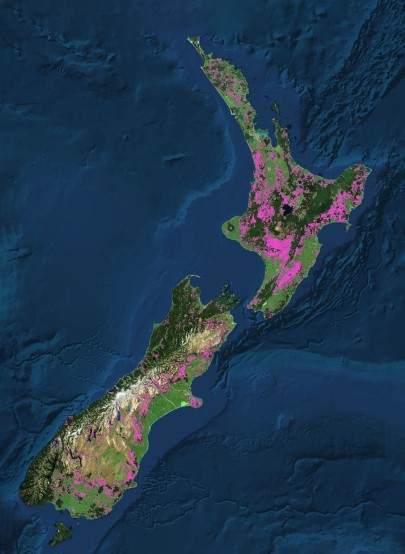Reforestation of former agricultural land through natural recolonisation by native trees is the best option for achieving native reforestation at scale given the prohibitive costs of tree planting. Reforestation through natural processes also reduces the chances of unintended consequences (especially replacement of naturally non-forested landscapes) relative to plantation forestry.

Pink areas indicate marginal agricultural land where natural reforestation is likely to occur following retirement of land from production. Over 3 million hectares could be reforested in this way.
But which types of trees are quickest to recolonise once the farmland is taken out of production? Are they species that rely on seeds being wind-dispersed, or those spread by animals or birds? Are the successful colonisers more able to withstand browsing? And can this knowledge be used to boost recolonisation processes?
These questions sound simple, but in practice they are very difficult to answer because forest successions take decades or even centuries. To overcome this problem, a common approach is to study many plots of different-aged stands of trees in a ‘space for time’ substitution. However, this approach is prone to problems, because older stands may occur in different environments from younger stands, so it is hard to separate the effects of stand age from the effects of environmental variations.
In response, researchers at Manaaki Whenua, led by Dr Norm Mason, undertook a ‘dynamic stand reconstruction’ approach at 14 sites across Aotearoa New Zealand where former agricultural land has been reforested. Taking measurements of tree stand age and growth rings, traits such as tree height, seed weight and seed dispersal, and the palatability of the leaves to browsing animals, 128 forest plots were studied across the 14 sites. Altogether, nearly 2,500 samples from 30 different tree species were included in the analysis, enabling patterns of tree succession to be established.
The results showed that the earliest-arriving tree species did not rely on animal or bird dispersal, had smaller leaves, and a chemistry that made them unpalatable to browsers. Later arrivals tended to have seeds brought in by birds and were more palatable.
One explanation for this is that unpalatable trees repel herbivores, thereby later allowing palatable species to establish. Another possibility is that Aotearoa New Zealand’s long history of grazing means surviving remnant patches of forest, from which trees spread, tend to contain more unpalatable species. The results for seed dispersal are probably due to birds being more likely to visit sites where woody cover has already established.
Either way, the findings suggest that controlling mammalian herbivores (such as deer and goats) and enhancing seed dispersal by birds may be important management interventions to accelerate natural reforestation at former agricultural sites. “Our study suggests stand reconstruction could be a useful tool for studying forest successions in New Zealand and it would be interesting to apply it to more sites to explore how factors such as climate and distance to forest affect the arrival of tree species during natural forest successions,” says Norm.
“In other work we’ve estimated that over 3 million hectares of marginal agricultural land could undergo natural forest succession if retired from production. We’re also exploring the potential for information sources such as the LUCAS [Land Use and Carbon Analysis System] land-use map to reveal historical patterns of natural reforestation.”

